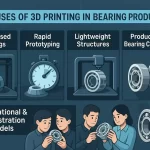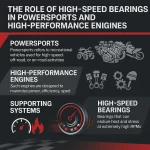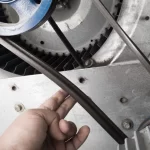Spherical Roller Bearing is designed to handle heavy-duty operations with higher loadbearing capacity and efficiency. This blog talks about various aspects to help you understand better about Spherical Roller Bearing.
The term “spherical roller bearing” refers to a type of rolling element bearing with spherical rollers that operate on the principle of rolling contact without sliding or fretting. The bearing can be used for many applications where radial loading is required. It can be classified as either a single row or double row depending upon whether it has one or two rows of balls between its inner ring and outer ring. These bearings have been widely applied in various industries including automobile, aerospace, wind energy generation, construction equipment, mining, off-road vehicles, marine, automotive transmission and agriculture sectors.
Spherical Roller Bearing - Designed for Heavy Loads
The term “spherical roller bearing” refers to a type of rolling-element bearing with spherical rollers that operate on the principle of rolling contact without sliding or fretting. The bearing can be used for many applications where radial loading is required. It can be classified as either a single row or double row depending upon whether it has one or two rows of balls between its inner ring and outer ring. These bearings have been widely applied in various industries including automobile, aerospace, wind energy generation, construction equipment, mining, off-road vehicles, marine, automotive transmission and agriculture sectors.
Spherical Roller Bearing Is Built For Tolerances
The major purpose of bearings is to prevent friction between the loads and there can be conditions when the bearing has to tolerate the misalignment due to the design and specification of machine operation. It can be bent shaft rotation where the shaft may deflect due to the increase in potential load or operation. In such cases, the spherical roller bearing comes as a savior to solve numerous challenges of manufacturing tolerances. Due to its unique design and efficiency, the spherical roller bearing can work quite well where the ball bearings might not work as optimum.
What are the Different Types Of Spherical Roller Bearing?
There are two types of Spherical Roller Bearing which are as follows:
- Spherical Roller – These types of bearings have the ability to adapt well to heavy radial loading. As in terms of design, they are barrel-shaped, they can bear possible angular errors and misalignments that can happen in the case of heavy-duty machinery due to higher load. Referring to the practical application, they can tolerate the conditions of misalignment between housing and shaft making it possible to attain parallelism without the scope of errors and breakdown.
- Spherical Roller Thrust – The Spherical Roller Thrust bearings come with an asymmetrical barrel shape roller that makes it capable to adjust well with a higher load and speed. The main application of this bearing is to maintain the higher capacity of thrust along with continuous alignment. In terms of its manufacturing and design, these bearings also result in a lesser fraction.
What Are The Features and Advantages of Spherical Roller Bearing?
The Spherical Bearings do offer greater benefits to their counterparts such as Ball Bearings whose applications and operating efficiency are limited. Since it is unique in terms of build quality, resistance, and design, the spherical roller bearings are widely used in high-performance and heavy-duty applications.
Here are various features which are as follows:
- Self-Aligning Feature – Spherical roller bearings have the capability to self-align themselves during operation. The inner race can be adjusted until it is perfectly centred on the outer race. No special tools are required for this process and the bearing itself is designed in such a way as to maintain its state
- Low Bearing Diameter – Spherical rollers require less bearing diameter than other types of ball bearings. For example, when using an 8 mm bearing, you will only need 4 mm between your inner and outer races.
- High Load Capacity – Spherical roller bearings are designed to handle higher load capacities than other bearings. They also offer superior performance under adverse operating conditions such as temperature variations or vibration.
- Continuous Alignment – Spherical roller bearings maintain their alignment throughout the life cycle of the bearing. Unlike tapered roller bearings which must be realigned after each use, spherical roller bearings can continue to operate without any maintenance
- Extremely Smooth Operation – Spherical roller bearings provide extremely smooth operations due to their unique design. They are designed to deliver utmost efficiency in any kind of machine or equipment to power smooth operation.
- Easy Maintenance – Spherical roller bearings require little maintenance compared to other types of bearings. You just need to clean out the grease once every six months.
- Ideal For Heavy Duty Applications – Spherical roller bearings are often used in applications where there is a requirement for heavy-duty operation. These include earthmoving equipment, mining machines, industrial machinery, construction vehicles, marine vessels, wind turbines, and so on.
Understanding Application Of Spherical Roller Bearing
The Spherical Roller Bearings can be used in conditions or machinery where the load you need to carry exceeds the load rating of other types of bearings, such as ball bearings. The outer ring has two rows of rolling elements separated by a radial gap. These rolling elements contact the inner race surface at both ends. Because there is no separate cage or retainer, the rolling elements can move freely within the radial gap. As the spherical roller rotates, they will always be aligned on their axis of rotation; therefore, they do not require any special alignment method.
List of Industries Using Roller Bearing
Roller bearings find widespread use across a variety of industry segments due to their ability to handle heavy loads, high speeds, and diverse operating conditions. Here’s a list of industry segments where roller bearings are commonly employed:
- Automotive Industry: Roller bearings are extensively used in automotive applications such as wheel hubs, transmissions, engines, steering systems, and suspension systems.
- Industrial Machinery: Roller bearings are crucial components in industrial machinery including machine tools, conveyors, pumps, compressors, gearboxes, printing presses, and textile machinery.
- Aerospace Industry: Roller bearings are utilized in aircraft engines, landing gear systems, flight control mechanisms, and various other aerospace applications due to their reliability and performance under extreme conditions.
- Construction Equipment: Roller bearings are found in construction equipment like cranes, excavators, loaders, bulldozers, and compactors, where they facilitate smooth operation and withstand heavy loads.
- Railway Industry: Roller bearings are used in railway applications such as locomotives, freight cars, passenger cars, and rail infrastructure components to support wheels, axles, and rotating mechanisms.
- Mining and Quarrying: Roller bearings are employed in mining equipment such as crushers, screens, conveyors, and drills, where they endure heavy loads, shock, and vibration.
- Power Generation: Roller bearings are used in power generation equipment such as turbines, generators, and wind turbines to support rotating shafts and ensure efficient energy conversion.
- Marine Industry: Roller bearings are utilized in marine applications such as ship propulsion systems, steering systems, winches, and deck machinery, where they withstand harsh environmental conditions.
- Renewable Energy: Roller bearings are critical components in renewable energy systems like wind turbines and solar trackers, supporting rotor shafts and ensuring smooth operation for optimal energy production.
- Steel and Metal Processing: Roller bearings are essential in steel mills, metal processing plants, and forging operations where they support heavy rotating machinery and equipment.
These are just a few examples of the diverse range of industry segments where roller bearings are widely used, highlighting their importance in modern manufacturing, transportation, and infrastructure.
Conclusion
The Spherical Roller Bearing is a great solution for industries that require heavy-duty tolerance and load in terms of bearings. It not only meets the demand for modern mechanized machinery but makes operations efficient and optimal to carry heavy loads.



















